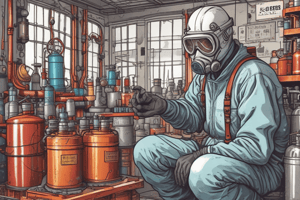Podcast
Questions and Answers
What is the primary purpose of regulatory agencies?
What is the primary purpose of regulatory agencies?
Regulating employee exposure to potentially toxic substances and informing employees about possible hazards.
What is an SDS? Where can you get these?
What is an SDS? Where can you get these?
Safety Data Sheet (SDS) for all chemical products.
List the four types of microorganisms pertinent to cosmetology.
List the four types of microorganisms pertinent to cosmetology.
Bacteria, viruses, fungi, parasites.
What is a contagious disease?
What is a contagious disease?
Is HIV a risk in the salon? Why or why not?
Is HIV a risk in the salon? Why or why not?
Cleaning involves removing all visible dirt and debris from tools using ___ and warm water.
Cleaning involves removing all visible dirt and debris from tools using ___ and warm water.
What is complete immersion?
What is complete immersion?
List at least six safety tips to follow when using disinfectants.
List at least six safety tips to follow when using disinfectants.
How do you know if an item can be disinfected?
How do you know if an item can be disinfected?
Can porous items be disinfected?
Can porous items be disinfected?
What are standard precautions?
What are standard precautions?
What is an exposure incident?
What is an exposure incident?
Describe the procedure for handling an exposure incident in the salon.
Describe the procedure for handling an exposure incident in the salon.
List the steps for cleaning and disinfecting whirlpool, air-jet, and pipe-less foot spas after each client.
List the steps for cleaning and disinfecting whirlpool, air-jet, and pipe-less foot spas after each client.
Flashcards
Regulatory Agencies
Regulatory Agencies
Government organizations that enforce safety rules and regulations, such as those related to workplace safety and hazardous materials.
Safety Data Sheets (SDS)
Safety Data Sheets (SDS)
Documents providing information on the hazards of chemicals and how to use them safely.
Microorganisms
Microorganisms
Tiny living things that are important in cosmetology (e.g., bacteria, viruses, fungi, parasites).
Contagious Diseases
Contagious Diseases
Signup and view all the flashcards
HIV Risk in Salons
HIV Risk in Salons
Signup and view all the flashcards
Cleaning
Cleaning
Signup and view all the flashcards
Disinfecting
Disinfecting
Signup and view all the flashcards
Sterilizing
Sterilizing
Signup and view all the flashcards
Complete Immersion
Complete Immersion
Signup and view all the flashcards
Disinfectability of Items
Disinfectability of Items
Signup and view all the flashcards
Standard Precautions
Standard Precautions
Signup and view all the flashcards
Exposure Incident
Exposure Incident
Signup and view all the flashcards
Handling Exposure Incidents
Handling Exposure Incidents
Signup and view all the flashcards
Cleaning and Disinfecting Foot Spas
Cleaning and Disinfecting Foot Spas
Signup and view all the flashcards
Study Notes
Regulatory Agencies and Safety
- Regulatory agencies ensure safe working conditions and inform employees about hazardous materials as outlined in the Occupational Safety and Health Act of 1970.
- Safety Data Sheets (SDS) must be available for all chemical products in salons, required by OSHA and state agencies.
Microorganisms Relevant to Cosmetology
- Four main types of microorganisms significant in cosmetology: bacteria, viruses, fungi, and parasites.
Contagious Diseases
- Contagious diseases spread from person to person, also referred to as communicable diseases. Common examples include colds, ringworm, conjunctivitis, and infections related to nails or feet.
HIV Risks in Salons
- HIV can be a risk in salon settings if tools become contaminated with a client’s blood, making proper cleaning and disinfecting essential to prevent infections.
Cleaning, Disinfecting, and Sterilizing
- Cleaning removes visible dirt using soap and water; disinfecting targets most microorganisms on nonporous surfaces, while sterilizing destroys all microbial life, though rarely mandated.
Complete Immersion
- Complete immersion requires sufficient liquid in a container to cover all surfaces of an item for at least 10 minutes, as specified by the manufacturer.
Safety Tips for Disinfectants
- Always have an SDS available for disinfectants.
- Use gloves and safety glasses when mixing disinfectants and avoid skin/eye contact.
- Dilute disinfectants by adding them to water to prevent foaming.
- Use tongs or gloves to remove items from disinfectants.
- Ensure disinfectants are stored out of children's reach.
Disinfectability of Items
- Multiuse (reusable) items can be cleaned and disinfected for use on multiple clients; examples include nippers, shears, combs, and metal pushers.
- Porous items cannot be properly disinfected and should be disposed of after a single use; examples include wooden sticks, cotton balls, and nail files.
Standard Precautions
- Standard precautions, guided by the CDC, suggest all human blood and body fluids should be treated as potentially infectious.
Exposure Incidents
- An exposure incident refers to contact with non-intact skin or potentially infectious materials during an employee’s duties.
Handling Exposure Incidents
- Immediate actions include stopping the service, informing the client, washing the injury, applying antiseptics, and disposing of contaminated materials properly.
- Ensure to disinfect all tools and items that may have been contaminated during the incident.
Cleaning and Disinfecting Foot Spas
- After each client, clean foot spas by draining water, scrubbing components with soap and warm water, and using EPA-registered disinfectants to mitigate infection risks.
- Follow specific procedures for end-of-day and weekly cleaning protocols to maintain hygiene standards.
Studying That Suits You
Use AI to generate personalized quizzes and flashcards to suit your learning preferences.




